Discover 35 hidden attractions, cool sights, and unusual things to do in Budapest (Hungary). Don't miss out on these must-see attractions: Heroes' Square, Szechenyi Baths, and St. Stephen's Basilica. Also, be sure to include Buda Castle in your itinerary.
Below, you can find the list of the most amazing places you should visit in Budapest (Budapest).
Table of Contents
Heroes' Square

Also known as: Hősök tere
Major square with landmark statues. Hősök tere, lit. Heroes' Square, is one of the major squares in Budapest, Hungary, noted for its iconic Millennium Monument with statues featuring the Seven chieftains of the Magyars and other important Hungarian national leaders, as well as the Memorial Stone of Heroes, often erroneously referred as the Tomb of the Unknown Soldier. The square lies at the outbound end of Andrássy Avenue next to City Park. It hosts the Museum of Fine Arts and the Palace of Art. The square has played an important part in contemporary Hungarian history and has been a host to many political events, such as the reburial of Imre Nagy in 1989. Most sculptures were made by sculptor György Zala from Lendava, with one made by György Vastagh.
In Budapest there are three more squares named Hősök tere, 'Heroes' Square', in the districts or neighbourhoods of Soroksár, Békásmegyer and Rákosliget.[1]
Address: Hősök tere, 1146 Budapest (Terézváros)
Szechenyi Baths
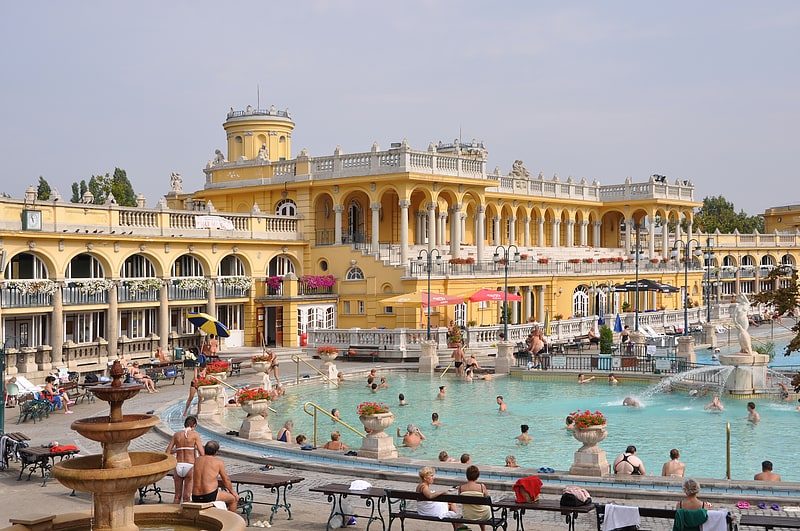
Also known as: Széchenyi gyógyfürdő
Grand spa with in- and outdoor pools. The Széchenyi Medicinal Bath in Budapest is the largest medicinal bath in Europe. Its water is supplied by two thermal springs, their temperature is 74 °C and 77 °C.
Components of the thermal water include sulfate, calcium, magnesium, bicarbonate and a significant amount of metaboric acid and fluoride.[2]
Address: Allatkerti korut 9-11, 1146 Budapest (Zugló)
St. Stephen's Basilica
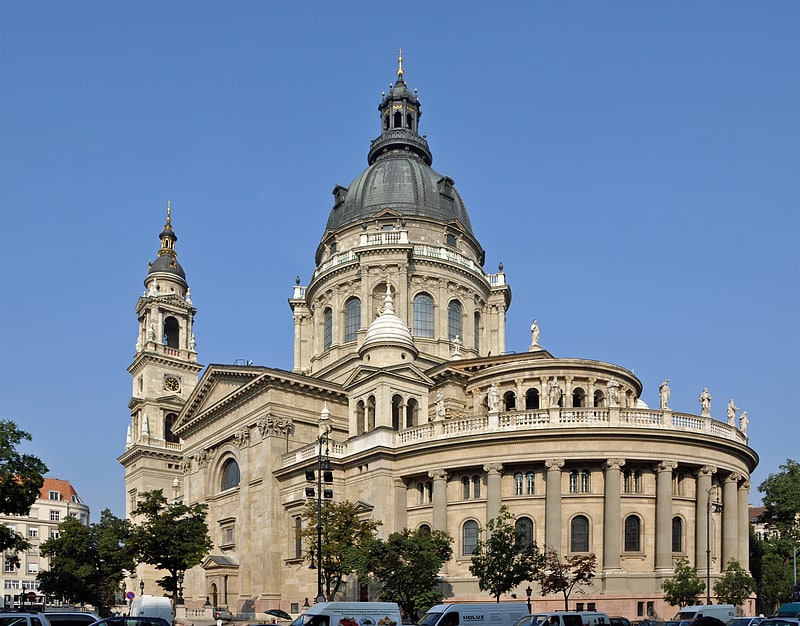
Also known as: Szent István-bazilika
Grand church with regular concerts. St. Stephen's Basilica is a Roman Catholic basilica in Budapest, Hungary. It is named in honour of Stephen, the first King of Hungary, whose right hand is housed in the reliquary. It was the sixth largest church building in Hungary before 1920. Since the renaming of the primatial see, it has been the co-cathedral of the Roman Catholic Archdiocese of Esztergom-Budapest. Today, it is the third largest church building in present-day Hungary.[3]
Address: Szent István tér 1, 1051 Budapest (Belváros-Lipótváros)
Buda Castle
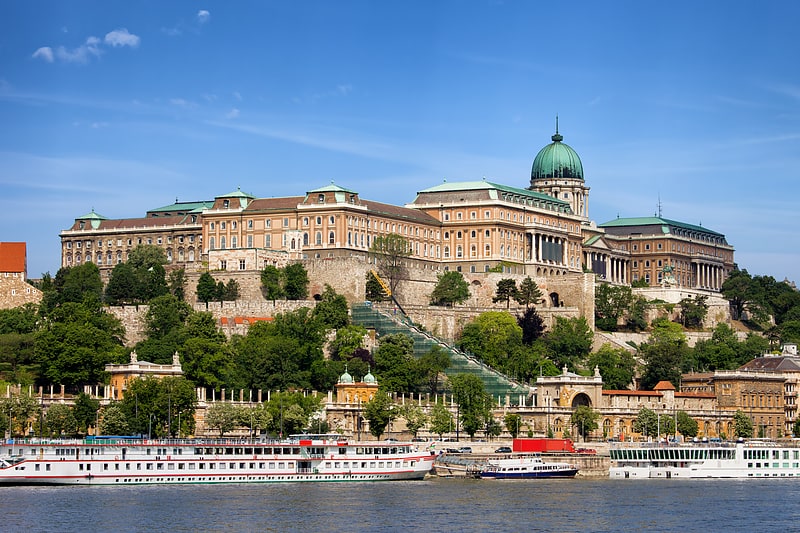
Also known as: Budavári Palota
Castle home of Hungarian art collection. Buda Castle is the historical castle and palace complex of the Hungarian kings in Budapest. It was first completed in 1265, although the massive Baroque palace today occupying most of the site was built between 1749 and 1769. The complex in the past was referred to as either the Royal Palace or the Royal Castle. The castle now houses the Hungarian National Gallery and The Budapest History Museum.
Buda Castle sits on the southern tip of Castle Hill, surrounded by the touristic area known as Várnegyed (Castle Quarter), which is famous for medieval, Baroque and Neoclassical houses, churches, public buildings, and monuments. The hill is linked to Clark Ádám Square and the Széchenyi Chain Bridge by the Castle Hill Funicular. The castle is a part of the Budapest World Heritage Site, so declared in 1987. The original Royal Palace was ruined during WWII, it was rebuilt in a simplified Stalin Baroque style during the Kádár era.[4]
Address: Szent György tér 2, 1014 Budapest (Várkerület)
Budapest Zoo & Botanical Garden

Also known as: Fővárosi Állat- és Növénykert
Established zoo with hundreds of species. Zoo & Botanical Garden of the Capital is the oldest zoo park in Hungary and one of the oldest in the world.
It has 1,072 animal species and is located within Városliget Park, unusually for a zoo, it is in the centre of the city.
The zoo opened its doors on 9 August 1866. The park has 1–1.1 million visitors every year. The area is a nature reserve, and has some valuable art nouveau buildings designed by Kornél Neuschloss and Károly Kós. More than 1,000 species are living there. The most special animals that are present in the zoo are the Komodo dragon and from December 2011 the wombat.
The zoo is located in the city centre and can be reached by Line 1 (Budapest Metro)
Official city card (Budapest card) owners get a 25% discount for a single ticket into the zoo.[5]
Address: Állatkerti krt. 6-12, 1146 Budapest (Zugló)
Chain Bridge
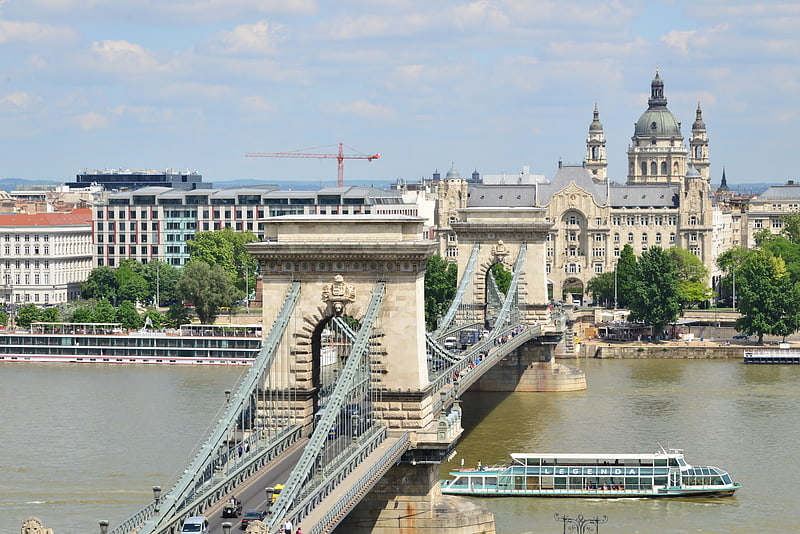
Also known as: Széchenyi lánchíd
Iconic 1800s stone suspension bridge. The Széchenyi Chain Bridge is a chain bridge that spans the River Danube between Buda and Pest, the western and eastern sides of Budapest, the capital of Hungary. Designed by English engineer William Tierney Clark and built by Scottish engineer Adam Clark, it was the first permanent bridge across the Danube in Hungary. It was opened in 1849. It is anchored on the Pest side of the river to Széchenyi Square, adjacent to the Gresham Palace and the Hungarian Academy of Sciences, and on the Buda side to Adam Clark Square, near the Zero Kilometre Stone and the lower end of the Castle Hill Funicular, leading to Buda Castle.
The bridge has the name of István Széchenyi, a major supporter of its construction, attached to it, but is most commonly known as the "Chain Bridge". At the time of its construction, it was regarded as one of the modern world's engineering wonders. It has asserted an enormous significance in the country's economic, social and cultural life, much as the Brooklyn Bridge has in New York and the US. Its decorations made of cast iron, and its construction, radiating calm dignity and balance, have elevated the Chain Bridge to a high stature in Europe.
It became a symbol of advancement, national awakening, and the linkage between East and West.[6]
Address: Széchenyi Lánchíd, 1051 Budapest (Várkerület)
Memento Park

Open air museum of Communist statues. Memento Park is an open-air museum in Budapest, Hungary, dedicated to monumental statues and sculpted plaques from Hungary's Communist period. There are statues of Lenin, Marx, and Engels, as well as several Hungarian Communist leaders. The park was designed by Hungarian architect Ákos Eleőd, who won the competition announced by the Budapest General Assembly in 1991. On public transport diagrams and other documents the park is usually shown as Memorial Park.
A quote by the architect on the project: "This park is about dictatorship. And at the same time, because it can be talked about, described, built, this park is about democracy. After all, only democracy is able to give the opportunity to let us think freely about dictatorship."
Memento Park is divided into two sections: Statue Park, officially named "A Sentence About Tyranny" Park after a poem of the same name by Gyula Illyés, and laid out as 6 oval sections; and Witness Square (also called "Neverwas Square"), which lies east of the main park entrance and is visible without payment. Statue Park houses 42 of the statues/monuments that were removed from Budapest after the fall of communism. Witness Square holds a replica of Stalin's Boots which became a symbol of the Hungarian Revolution of 1956 after the statue of Stalin was pulled down from its pedestal in 1956, and is flanked by two single storey timber structures housing the internal exhibition space, their design being evocative of simple internment camp buildings.[7]
Address: Balatoni út - Szabadkai utca sarok, 1223 Budapest
Hungarian Railway Museum
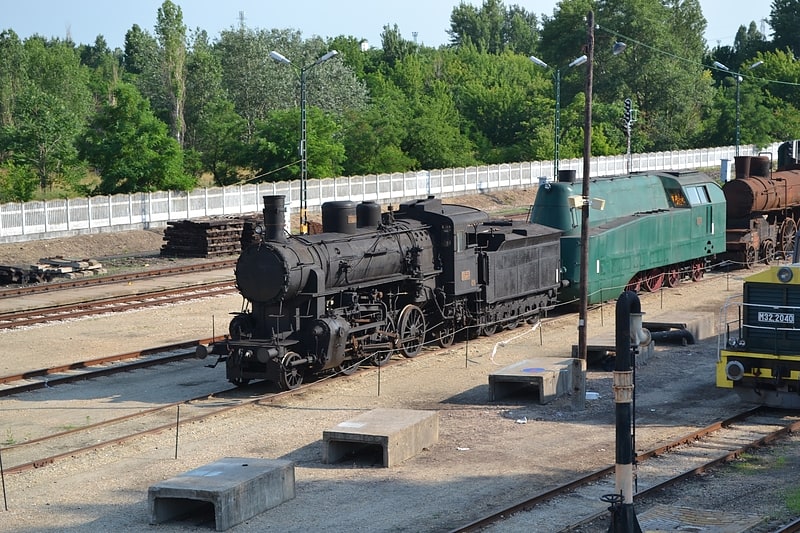
Also known as: Magyar Vasúttörténeti Park
Railway museum with hands-on activities. The Magyar Vasúttörténeti Park is a railway museum located in Budapest, Hungary at a railway station and workshop of the Hungarian State Railways, the former Budapest North Depot. The museum covers more than 70,000 square meters and it features over one hundred exhibits, mostly including railway vehicles and equipment.[8]
Address: Tatai út 95, 1142 Budapest (Zugló)
Great Market Hall
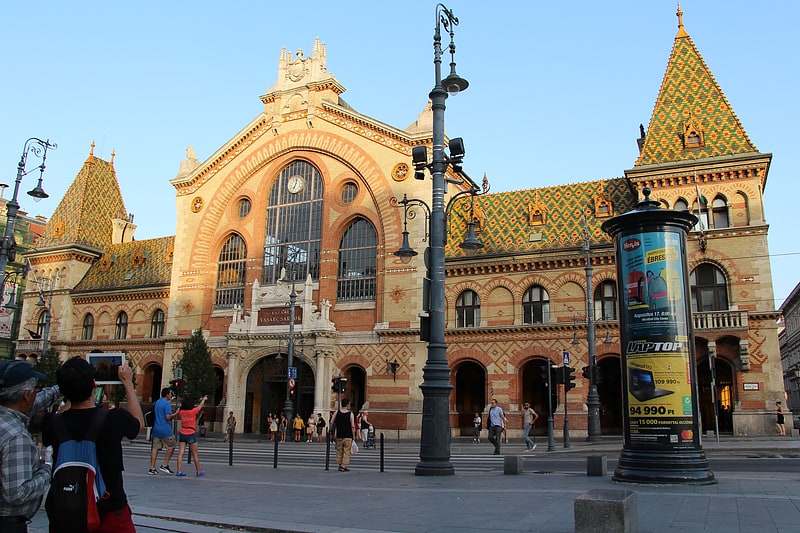
Also known as: Központi Vásárcsarnok
Huge market built in late 19th-century. The Great Market Hall or Central Market Hall, Market Hall I is the largest and oldest indoor market in Budapest, Hungary. The idea of building such a large market hall arose from the first mayor of Budapest, Károly Kamermayer, and it was his largest investment. He retired in 1896 and participated in the opening ceremony on February 15, 1897.
It is located at the end of the famous pedestrian shopping street Váci utca and on the Pest side of the Liberty bridge at Fővám square.[9]
Address: Vámház krt. 1-3, 1093 Budapest (Ferencváros)
Vajdahunyad Castle
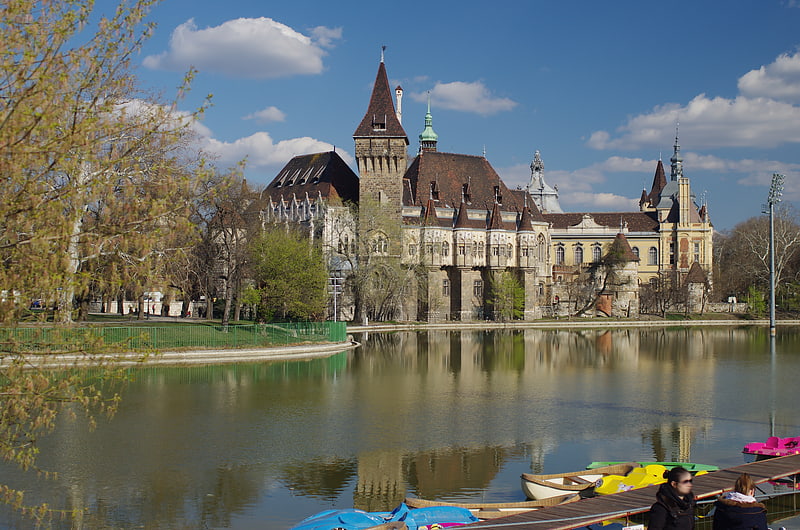
Also known as: Vajdahunyad vára
Fantastical castle with a boating lake. Vajdahunyad Castle is a castle in the City Park of Budapest, Hungary. It is a copy of Hunyad Castle, known as Corvin Castle, in Hunedoara, Romania. It was built in 1896 as part of the Millennial Exhibition which celebrated the 1,000 years of Hungary since the Hungarian Conquest of the Carpathian Basin in 895. The castle was designed by Ignác Alpár to feature copies of several landmark buildings from different parts of the Kingdom of Hungary, especially the Hunyad Castle in Transylvania. As the castle contains parts of buildings from various time periods, it displays different architectural styles: Romanesque, Gothic, Renaissance, and Baroque. Originally, it was made from cardboard and wood, but it became so popular that it was rebuilt from stone and brick between 1904 and 1908. Today, it houses the Museum of Hungarian Agriculture, the biggest agricultural museum in Europe.
The statue of the chronicler Anonymus (by Miklós Ligeti) is also displayed in the castle court. Anonymus lived in the 12th century (his true identity is unknown, but he was a notary of Béla III of Hungary), who wrote the chronicle Gesta Hungarorum (Deeds of the Hungarians).
The external wall of the castle contains a bust of Béla Lugosi, a Hungarian-American actor famous for portraying Count Dracula in the original 1931 film.[10]
Address: Vajdahunyad stny., 1146 Budapest (Zugló)
City Park
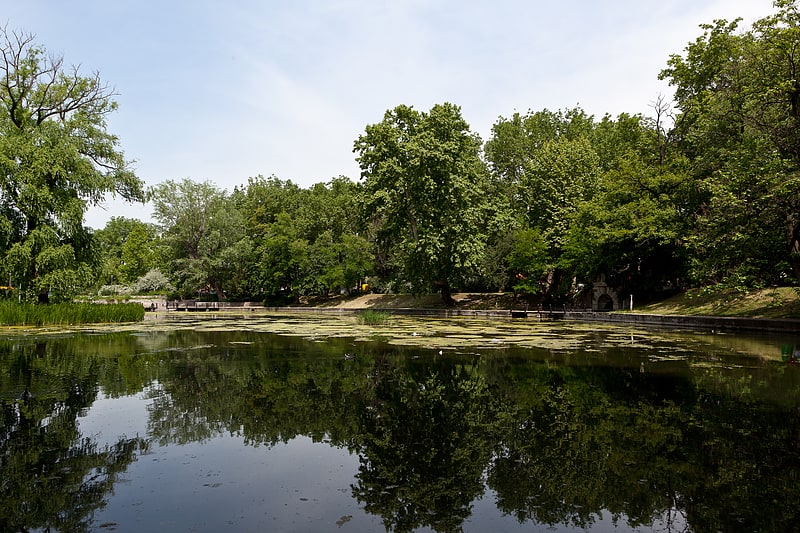
Also known as: Városliget
Museum and attraction-filled city park. The City Park is a public park close to the centre of Budapest, Hungary. It is a 0.9-by-0.6-mile rectangle, with an area of 302 acres, located in District XIV of Budapest, between Hungária körút, Ajtósi Dürer sor, Vágány utca and Dózsa György út. Its main entrance is at Heroes' Square, one of Hungary's World Heritage sites.[11]
Address: Heroes' Square, Budapest (Zugló)
Matthias Church
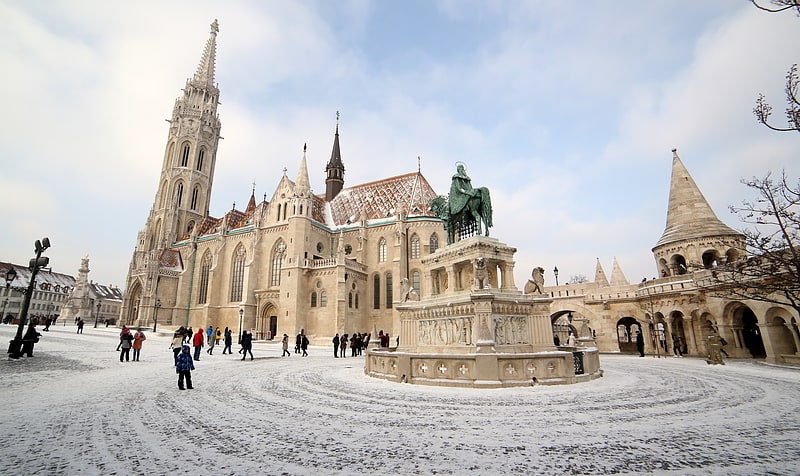
Also known as: Mátyás-templom
Late-Gothic Roman Catholic church. The Church of the Assumption of the Buda Castle, more commonly known as the Matthias Church, more rarely the Coronation Church of Buda, is a Roman Catholic church located in the Holy Trinity Square, Budapest, Hungary, in front of the Fisherman's Bastion at the heart of Buda's Castle District. According to church tradition, it was originally built in Romanesque style in 1015, although few references exist. The current building was constructed in the florid late Gothic style in the second half of the 14th century and was extensively restored in the late 19th century. It was the second largest church of medieval Buda and the seventh largest church of the medieval Hungarian Kingdom.
It is a historic building with an important history. Two Kings of Hungary were crowned within its walls: Franz Joseph I of Hungary and Elisabeth, and Charles IV of Hungary and Zita of Bourbon-Parma.
The church was also the location of the "Marian Miracle" of Buda. In 1686, during the siege of Buda city by the Holy League, a wall of the church - used as a mosque by the Ottoman occupiers of the city - collapsed due to cannon fire. It turned out that an old votive Madonna statue was hidden behind the wall. As the sculpture of the Virgin Mary appeared before the praying Muslims, the morale of the Muslim garrison collapsed and the city fell on the same day.[12]
Address: Szentharomsag ter 2, 1014 Budapest (Várkerület)
Museum of Applied Arts

Also known as: Iparművészeti Múzeum
Museum in Budapest, Hungary. The Museum of Applied Arts is a museum in Budapest, Hungary. It is the third-oldest applied arts museum in the world.[13]
Address: Ulloi ut 33-37., 1091 Budapest (Ferencváros)
Dohány Street Synagogue

Also known as: Dohány utcai zsinagóga
Iconic 19th-century religious complex. The Dohány Street Synagogue, also known as the Great Synagogue or Tabakgasse Synagogue, is a historical building in Erzsébetváros, the 7th district of Budapest, Hungary. It is the largest synagogue in Europe, seating 3,000 people and is a centre of Neolog Judaism.
The synagogue was built between 1854 and 1859 in the Moorish Revival style, with the decoration based chiefly on Islamic models from North Africa and medieval Spain (the Alhambra). The synagogue's Viennese architect, Ludwig Förster, believed that no distinctively Jewish architecture could be identified, and thus chose "architectural forms that have been used by oriental ethnic groups that are related to the Israelite people, and in particular the Arabs". The interior design is partly by Frigyes Feszl.
The Dohány Street Synagogue complex consists of the Great Synagogue, the Heroes' Temple, the graveyard, the Memorial and the Jewish Museum, which was built on the site on which Theodor Herzl's house of birth stood. Dohány Street itself, a leafy street in the city center, carries strong Holocaust connotations as it constituted the border of the Budapest Ghetto.[14]
Address: Dohány u. 2, 1074 Budapest (Erzsébetváros)
Lukács Baths
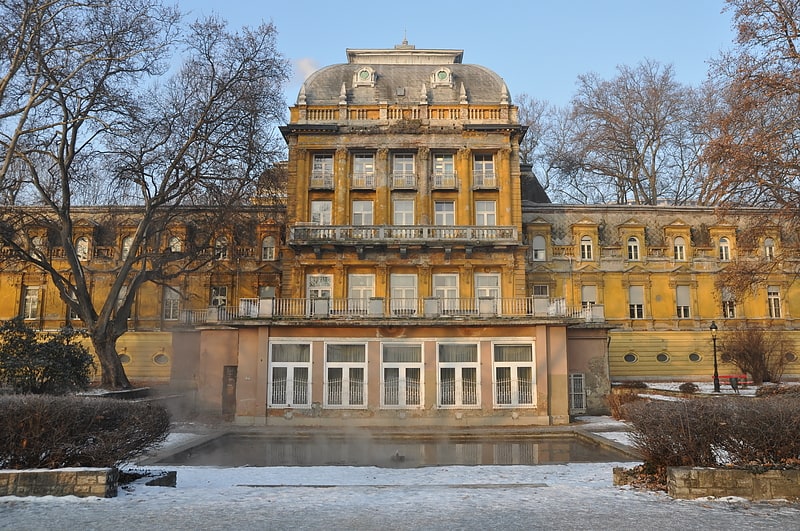
The Lukács Thermal Bath is a historic indoor/outdoor thermal bath spa in Budapest, Hungary, heated naturally by hotsprings. It can be used by men and women every day; however, the swimming pools have historical names such as men swimming pool and women swimming pool. There are ticket with lockers or cabins. All pools and four saunas can be used by all ticket basically. The only optional area is the sauna world, which contains five more saunas, ice cooling pool, igloo and heated roman bench. There are sauna nights in this bath on Fridays of every even week from 20:00 to 02:00.[15]
Address: Frankel Leó út 25-29, 1023 Budapest (Rózsadomb)
Museum of Fine Arts
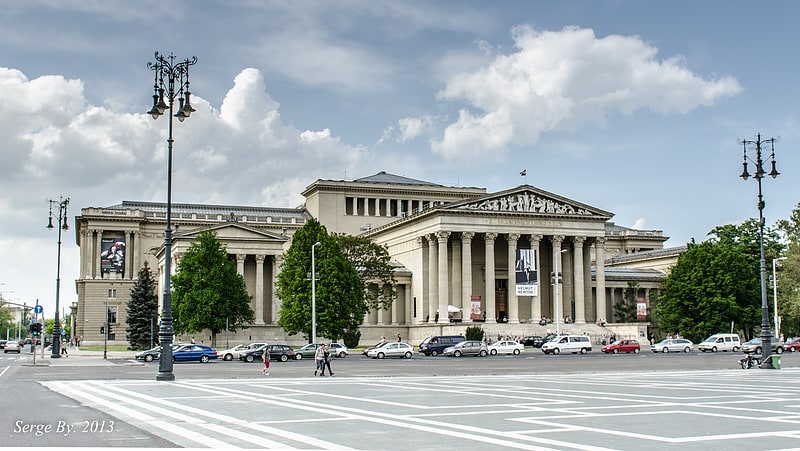
Also known as: Szépművészeti Múzeum
Fine-art museum in neoclassical building. The Museum of Fine Arts is a museum in Heroes' Square, Budapest, Hungary, facing the Palace of Art.
It was built by the plans of Albert Schickedanz and Fülöp Herzog in an eclectic-neoclassical style, between 1900 and 1906. The museum's collection is made up of international art (other than Hungarian), including all periods of European art, and comprises more than 100,000 pieces. The collection is made up of older additions such as those from Buda Castle, the Esterházy and Zichy estates, as well as donations from individual collectors. The Museum's collection is made up of six departments: Egyptian, Antique, Old sculpture gallery, Old master paintings gallery, Modern collection, Graphics collection. The institution celebrated its centenary in 2006.[16]
Address: Dózsa György út 41, 1146 Budapest (Zugló)
Fisherman's Bastion
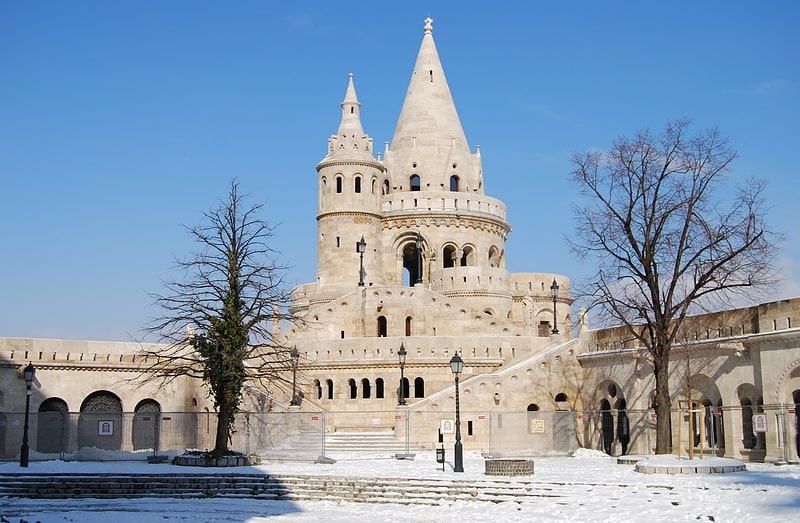
Also known as: Halászbástya
Turreted fortress and city views. The Halászbástya or Fisherman's Bastion is one of the best known monuments in Budapest, located near the Buda Castle, in the 1st district of Budapest. It is one of the most important tourist attractions due to the unique panorama of Budapest from the Neo-Romanesque lookout terraces. The Fishermen's Bastion's main façade, parallel to the Danube, is approximately 140 meters long, of which the southern aisle is about 40 meters long, the north is 65 meters long, and the ornate central parapet is 35 meters long. Its seven high-pitched stone towers symbolize the seven chieftains of the Hungarians who founded Hungary in 895.
The original walls were built in the 1700s, forming part of the walls of a castle. Several historians say that in the Middle Ages this part of the castle walls was protected by the guild of fishermen (halász), who lived under the walls in the so-called Fishtown or Watertown. The current structure was built between 1895 and 1902, in Neo-Romanesque style, on the base of a stretch of the Buda Castle walls, by architect Frigyes Schulek, who was also responsible for the restoration of the Matthias Church.
Since 1987 it has been one of Budapest's World Heritage Sites as part of the Várkerület District (Buda Castle District).[17]
Address: Hess András tér 1-2, 1014 Budapest (Várkerület)
Liberty Statue
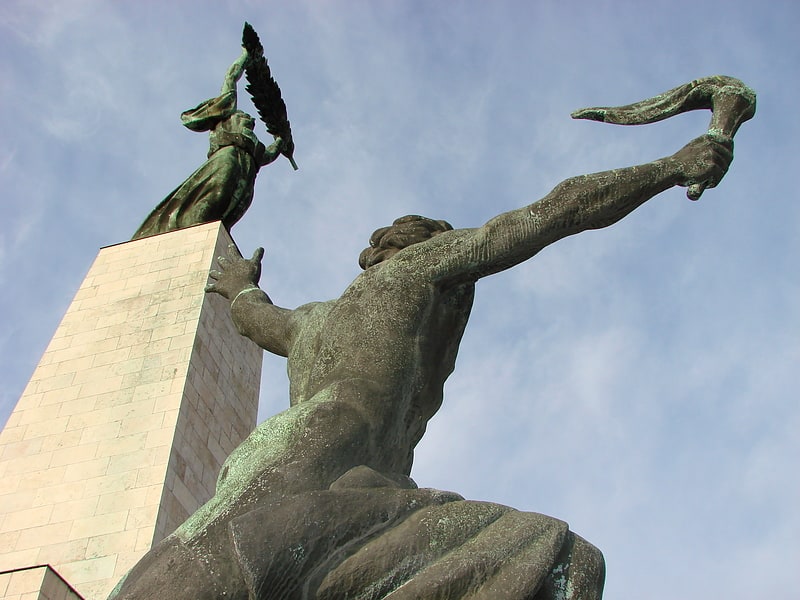
Also known as: Szabadság-szobor
Hilltop memorial to the war dead. The Liberty Statue or Freedom Statue is a monument on the Gellért Hill in Budapest, Hungary. It commemorates those who sacrificed their lives for the independence, freedom, and prosperity of Hungary.[18]
Address: Citadella sétány, Budapest (Újbuda)
Citadella
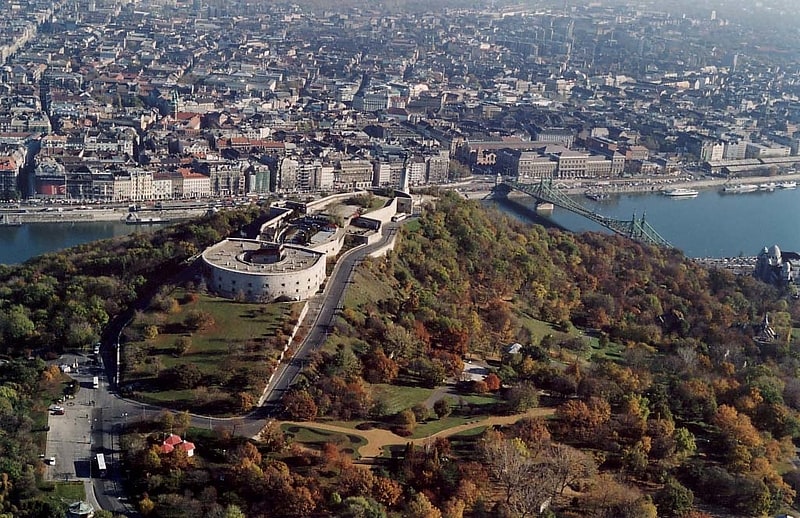
Hapsburg fortress with views of the city. The Citadella is the fortification located upon the top of Gellért Hill in Budapest, Hungary. Citadella is the Hungarian word for citadel, a kind of fortress. The word is exclusively used by other languages to refer to the Gellért Hill citadel which occupies a place which held strategic importance in Budapest's military history.[19]
Address: Citadella setany 1, 1118 Budapest (Újbuda)
Müpa Budapest
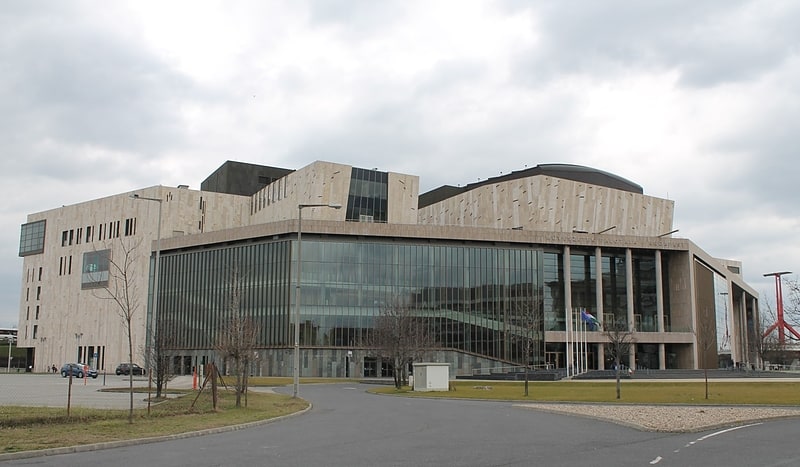
Also known as: Müpa
Building in Budapest, Hungary. Müpa Budapest is a building in Ferencváros, Budapest, Hungary, officially opened in March 2005. It is located near Rákóczi Bridge and was designed by Zoboky, Demeter and Partners Architectural Office. The National Theatre, which opened in 2002, is located next to it.
Both Müpa Budapest and the National Theatre are part of the new Millennium City Center being created in Budapest.
The structure of Müpa Budapest covers a ground area of 10,000 m² and the total floor space of the building is 70,000 m². It received the Prix d’Excellence of FIABCI in 2006.
The general manager is Csaba Kael.[20]
Address: Budapest, 1095 Budapest, Komor Marcell u. 1.
Hungarian Natural History Museum
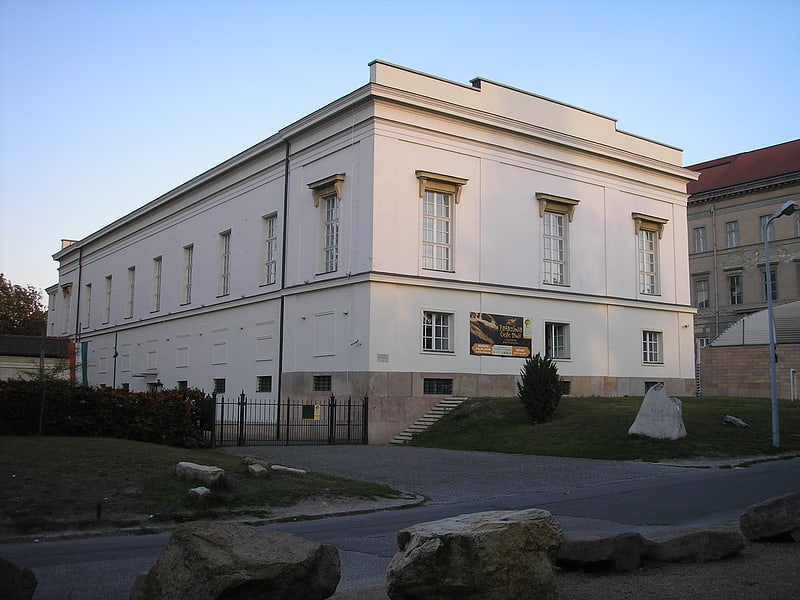
Also known as: Magyar Természettudományi Múzeum
Expansive natural history museum. The Hungarian Natural History Museum in Budapest, dating back to 1802, houses the largest natural history collections of Hungary and the region.[21]
Address: Ludovika ter 2-6, 1083 Budapest
Hungarian State Opera House
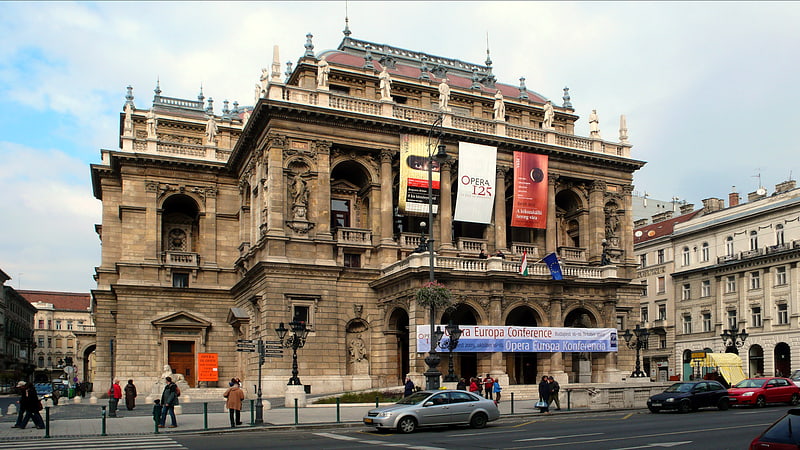
Also known as: Magyar Állami Operaház
Elegant state opera house with frescoes. The Hungarian State Opera House is a neo-Renaissance opera house located in central Budapest, on Andrássy út. Originally known as the Hungarian Royal Opera House, it was designed by Miklós Ybl, a major figure of 19th-century Hungarian architecture. Construction began in 1875, funded by the city of Budapest and by Emperor Franz Joseph I of Austria-Hungary, and the new house opened to the public on the 27 September 1884. Before the closure of the "Népszínház" in Budapest, it was the third largest opera building in the city; today it is the second largest opera house in Budapest and in Hungary.
Touring groups had performed operas in the city from the early 19th century, but as Legány notes, "a new epoch began after 1835 when part of the Kasa National Opera and Theatrical Troupe arrived in Buda". They took over the Castle Theatre and, in 1835, were joined by another part of the troupe, after which performances of operas were given under conductor Ferenc Erkel. By 1837 they had established themselves at the Magyar Színház (Hungarian Theatre) and by 1840, it had become the "Nemzeti Színház" (National Theatre). Upon its completion, the opera section moved into the Hungarian Royal Opera House, with performances quickly gaining a reputation for excellence in a repertory of about 45 to 50 operas and about 130 annual performances.
Today, the opera house is home to the Budapest Opera Ball, a society event dating back to 1886.[22]
Address: Budapest, Andrássy Ave 22.
Hungarian National Museum

Also known as: Magyar Nemzeti Múzeum
Museum of Hungarian history and culture. The Hungarian National Museum was founded in 1802 and is the national museum for the history, art, and archaeology of Hungary, including areas not within Hungary's modern borders, such as Transylvania; it is not to be confused with the collection of international art in the Hungarian National Gallery. The museum is in Budapest VIII in a Neoclassical building, purpose-built during 1837–47 by the architect Mihály Pollack.[23]
Address: Muzeum korut 14-16, 1088 Budapest
Rákóczi Square Market Hall
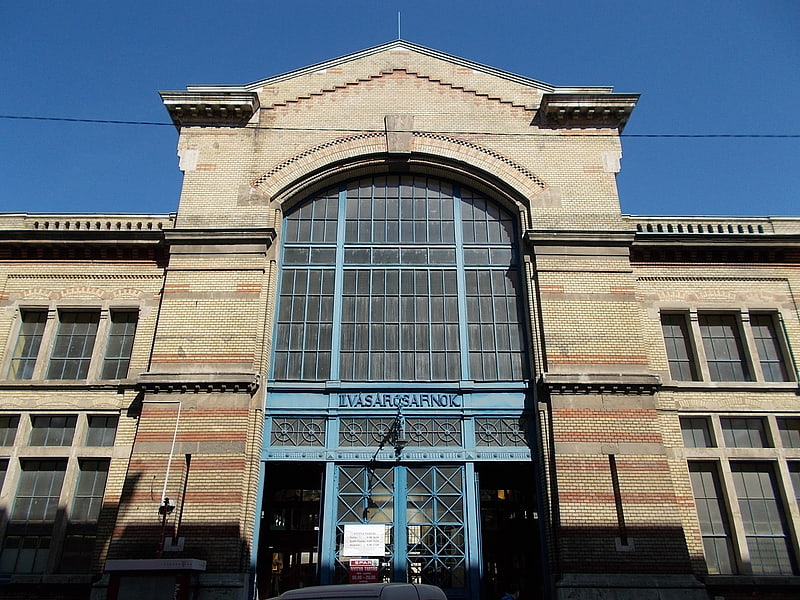
The Rákóczi Square Market Hall or Market Hall II is one of the great Budapest market halls built during the monarchy. It was originally opened in 1894 and has been operating in its present form since 1991. This institution was named after the new district of Józsefváros in 2012, the Hall quarter.
The Rákóczi tér market hall was the second of the large Budapest market halls built in the VIII. In 1890, Győző Czigler made a proposal for its replacement. It was built in 1894 and designed by István Rozinay and Pál Klunzinger. The hall opened to customers in 1897.
In the post-delivery period, a horse-drawn carriage could be driven into the hall at the main entrance from Rákóczi Square, thus facilitating unloading. Inside the hall there were 4 and 6 m² storehouses, with a total of 375 permanent and 55 temporary stores. The cellar was used for storage, while the corner pavilions housed a shopkeeper, police, hall control, first aid and restaurants. Above them were rented apartments.
By 1936, the traffic in the hall had become so low that it was planned to close it or transform it into a swimming pool, but these plans were not realized later. On the night of May 6, 1988, a fire broke out in the hall and the building burned down. The market hall was not demolished, but it was renovated according to the plans of the architects György Tokár and György Hidasi, and reopened on 25 July 1991.[24]
Address: VIII. Rákoci tér 7-9, Budapest
Elisabeth Bridge
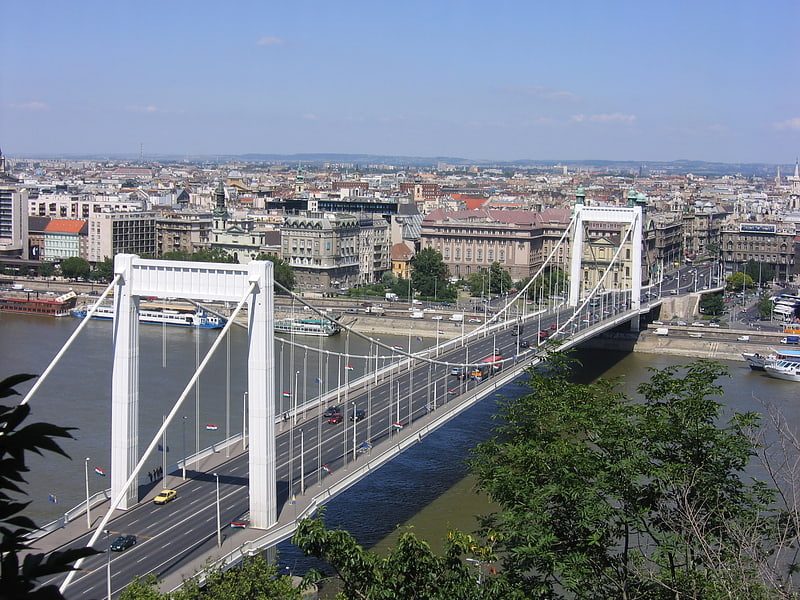
Also known as: Erzsébet híd
Bridge named after a popular Empress. Elisabeth Bridge is the third newest bridge of Budapest, Hungary, connecting Buda and Pest across the River Danube. The bridge is situated at the narrowest part of the Danube in the Budapest area, spanning only 290 m. It is named after Elisabeth of Bavaria, a popular queen and empress of Austria-Hungary, who was assassinated in 1898. Today, her large bronze statue sits by the bridge's Buda side connection in the middle of a small garden.
The original eclectic flamboyant style bridge was built between 1897 and 1903. It was destroyed during World War II, and a significantly simplified brutalist version was built without any ornamentation between 1961–1964.
Its two ends are:
- March 15 Square (with the oldest church in Pest, Inner City Parish Church, built in the 13th century) and the famous Mátyás Pince restaurant.
- Döbrentei Square in Buda with the monument of Saint Gellért on the Gellért Hill, a sculpture of Queen Elisabeth, and the Rácz Baths and Rudas Baths nearby. A luxury spa hotel is currently being built in the area.
Address: Erzsébet híd, 1053 Budapest (Várkerület)
Hungarian National Gallery
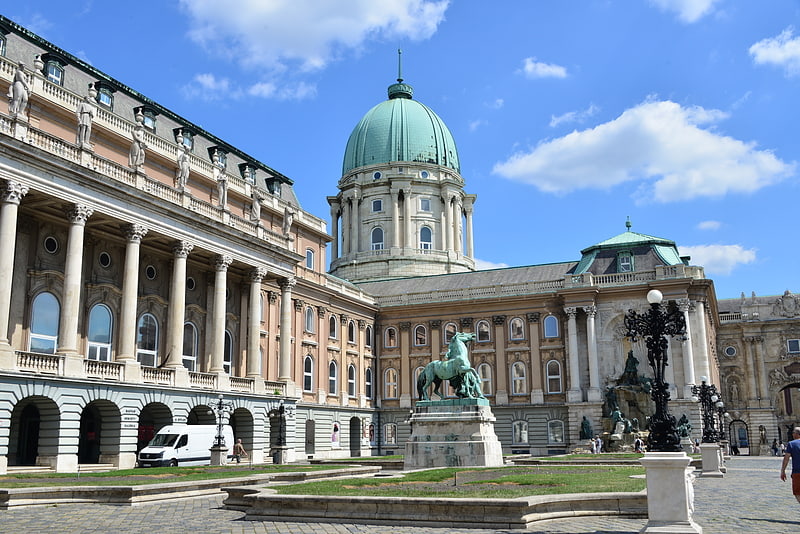
Also known as: Magyar Nemzeti Galéria
National art collection in former palace. The Hungarian National Gallery, was established in 1957 as the national art museum. It is located in Buda Castle in Budapest, Hungary. Its collections cover Hungarian art in all genres, including the works of many nineteenth- and twentieth-century Hungarian artists who worked in Paris and other locations in the West. The primary museum for international art in Budapest is the Museum of Fine Arts.[26]
Address: Szent Gyoergy ter 2, 1014 Budapest (Várkerület)
Saint Anne Parish
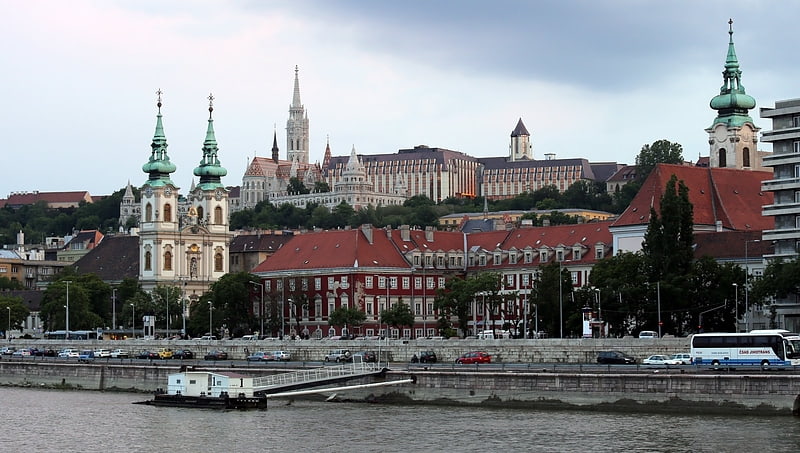
The Saint Anne Parish of Upper Watertown is a Roman Catholic parish church located in the Várkerület district, Budapest. The Saint Anne Parish Church of Upper Watertown, often used by its short name, St. Anne's Church, is one of the most significant buildings of the Batthyány tér. Its construction was started in 1740 according to the plans of master builder Kristóf Hamon, and after his death, Máté Nöpauer completed the building in 1761.[27]
Address: I, Batthyány tér 7, Budapest (Várkerület)
Bathory Cave
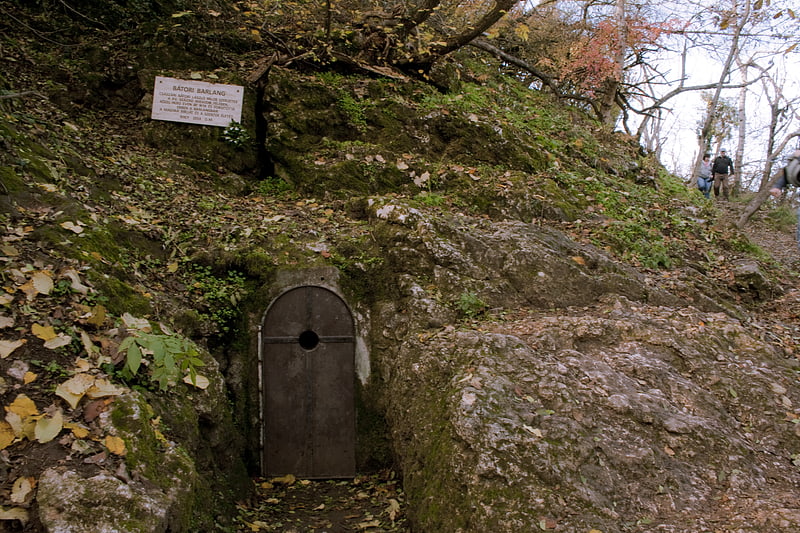
National park in Budapest, Hungary. The Bathory Cave is a cave located just below the top of Nagy-Hárs Hill, on the northeast side of the mountain. It is located within the Danube-Ipoly National Park and the 2nd district of Budapest. The cave gets its name from Pauline monk, László Báthory who used the cave as a hermitage for twenty years.[28]
Margaret Bridge
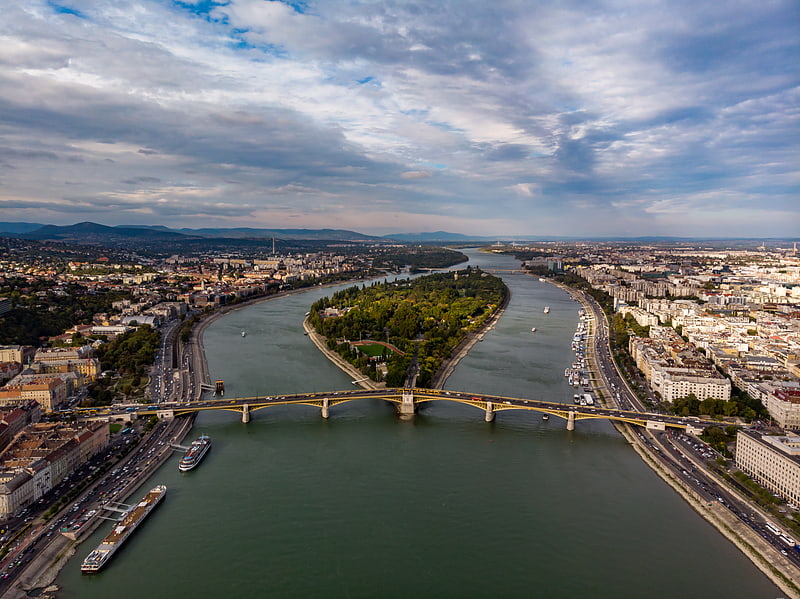
Also known as: Margit híd
Bridge in Budapest, Hungary. Margaret Bridge or Margit híd is a three-way bridge in Budapest, Hungary, connecting Buda and Pest across the Danube and linking Margaret Island to the banks. It is the second-northernmost and second-oldest public bridge in Budapest.
It was designed by French engineer Ernest Goüin and built by the construction company Maison Ernest Goüin et Cie. between 1872 and 1876, the engineer in charge being Émile Nouguier. Margaret Bridge was the second permanent bridge in Budapest after Széchenyi Chain Bridge. This bridge leads up to Margaret Island, its two parts enclosing 165 degrees with each other at the embranchment towards the island. The reason for this unusual geometry is that the small extension to connect to Margaret Island was hastily inserted into the original design but not built until two decades later due to lack of funds.
The bridge's two ends are
- Jászai Mari tér (northern end of Grand Boulevard) and
- Germanus Gyula park (stop of Szentendre HÉV; the Lukács and Király Baths are nearby).
It is 607.5 metres (1,993 ft) in length and 25 metres (82 ft) in width.[29]
Address: Margit híd, Budapest (Rózsadomb)
Tomb of Gül Baba
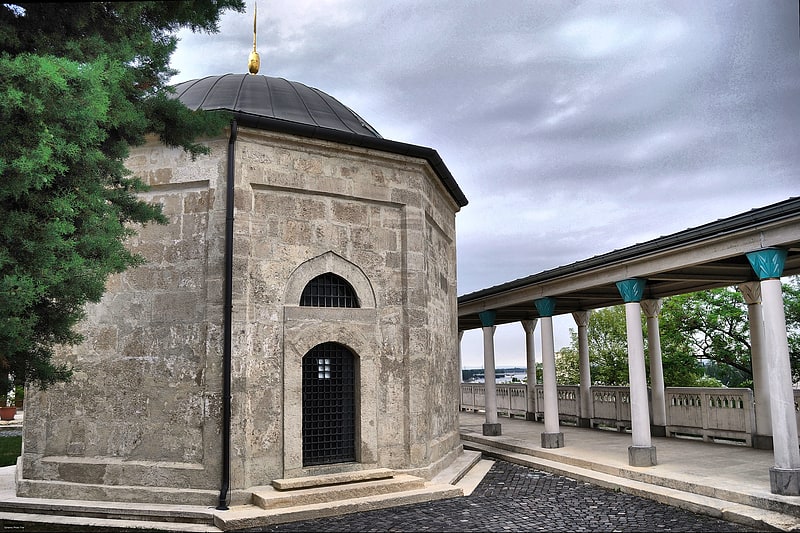
Also known as: Gül Baba türbéje
Museum in Budapest, Hungary. Gül Baba's tomb in Budapest, Hungary, is the northernmost Islamic pilgrimage site in the world. The mausoleum is located in the district of Rózsadomb on Mecset Street, a short but steep walk from Margaret Bridge.
Gül Baba was a member of the Bektás Dervish Order, who died in Ottoman Buda in 1541.[30]
Address: Mecset utca 14, 1023 Budapest (Rózsadomb)
Sándor Palace
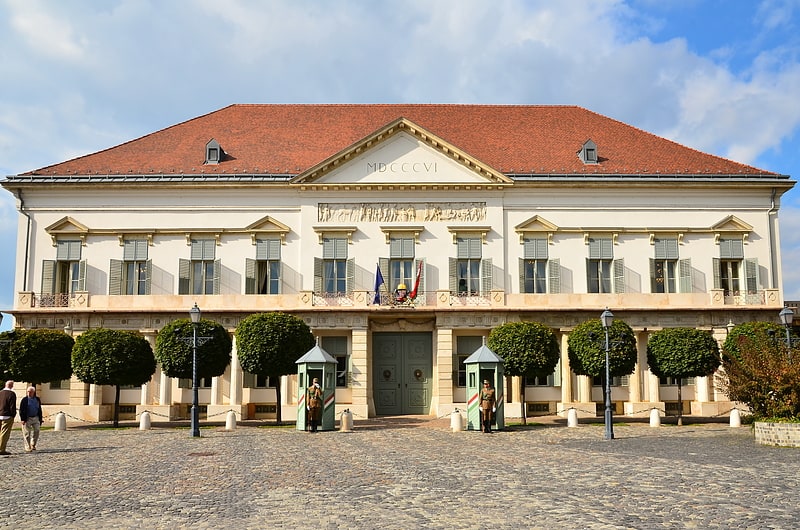
Also known as: Sándor-palota
State government office in Budapest, Hungary. The Sándor Palace is a palace in Budapest, Hungary. Located beside the Buda Castle complex in the ancient Castle District, it has served as the official residence and workspace of the President of Hungary since 2003.
Sándor Palace is the 37th largest palace in present-day Hungary.[31]
Address: Szent Gyorgy ter 1-2., 1014 Budapest (Várkerület)
Egyetemi Templom
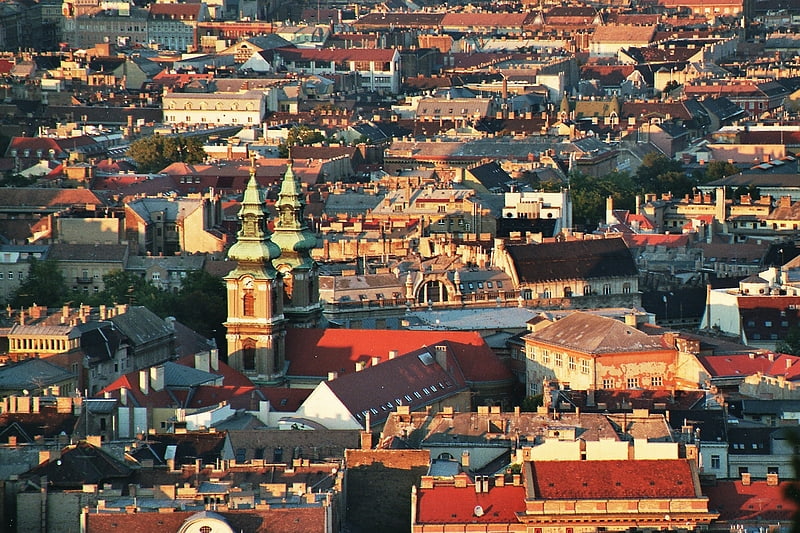
Church in Budapest, Hungary. The Church of St Mary the Virgin, commonly known as the University Church is a Catholic Church in the Papnövelde Street, Belváros-Lipótváros District in Budapest, Hungary. From 1786 the church belongs to the former Theological Faculty of the Eötvös Loránd University, and to the Pázmány Péter Catholic University independent of it; before it was the central church of the Pauline Order. The Central Priestly Educational Institute operates in a block adjacent to the church, so that the liturgical services of the church are performed by the priestly students and the chiefs of the institute. The church has two towers and its towers are 56 meters high.[32]
Matthias Fountain
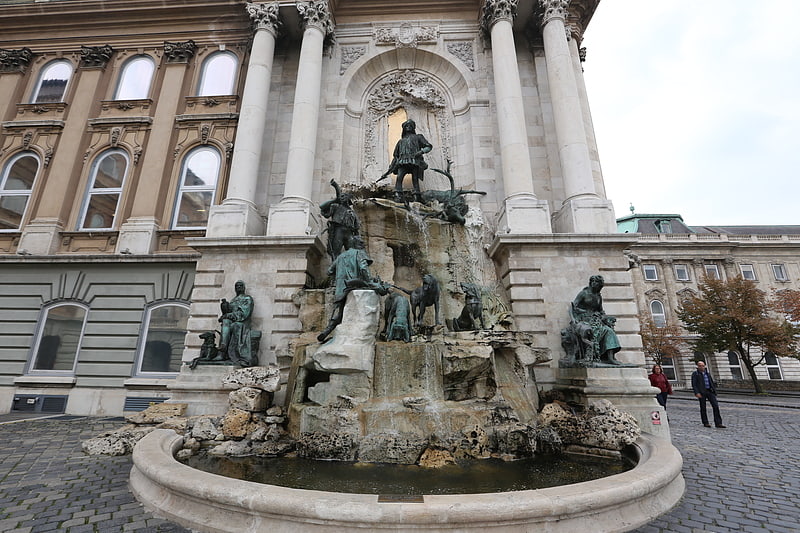
Matthias Fountain is a monumental fountain group in the western forecourt of Buda Castle, Budapest. Alajos Stróbl’s Neo-Baroque masterpiece is one of the most frequently photographed landmark in the Hungarian capital. It is sometimes called the ’Trevi Fountain of Budapest’.[33]
Address: Budapest Castle Courtyard, Budapest (Várkerület)
Erzsébetliget Theatre
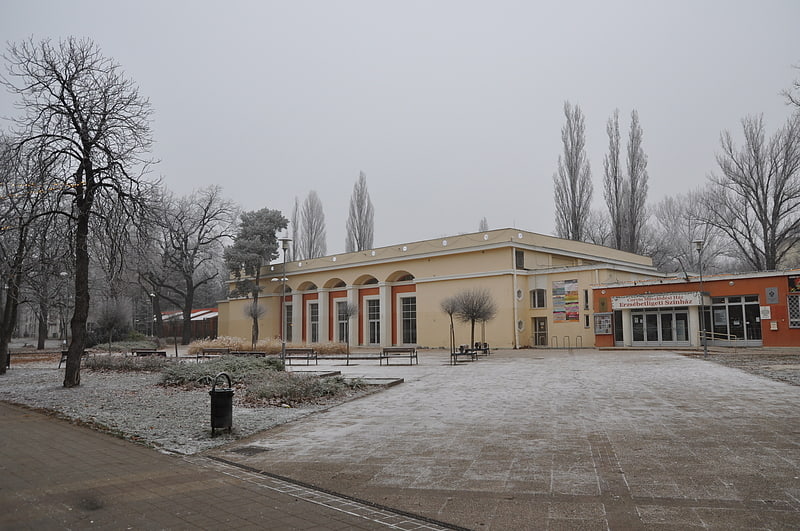
The Erzsébetliget Theatre is a theatre in Mátyásföld, Budapest.[34]
Address: XVI, Hunyadvár utca 43/c, Budapest
Shoes on the Danube Bank
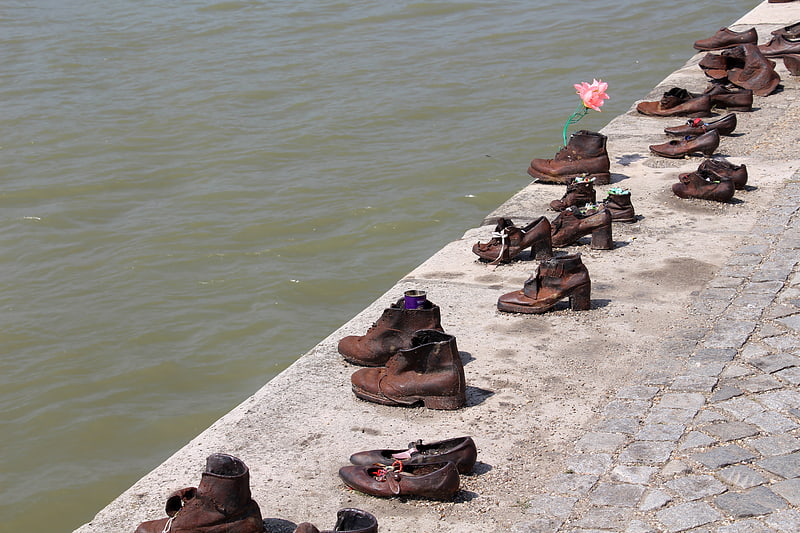
Also known as: Cipők a Duna-parton
Unique memorial sculpture by the river. The Shoes on the Danube Bank is a memorial erected on 16 April 2005, in Budapest, Hungary. Conceived by film director Can Togay, he created it on the east bank of the Danube River with sculptor Gyula Pauer to honour the Jews who were massacred by Fascist Hungarian militia belonging to the Arrow Cross Party in Budapest during the Second World War. They were ordered to take off their shoes, and were shot at the edge of the water so that their bodies fell into the river and were carried away. The memorial represents their shoes left behind on the bank.[35]
Address: Id. Antall Jozsef rakpart, 1054 Budapest (Belváros-Lipótváros)